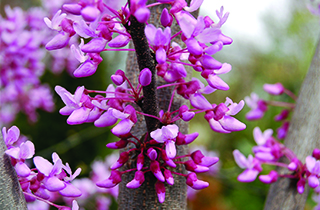Good Ol’ Eastern Redbud

Every spring I tell myself I’d like to plant a redbud tree, but somehow I still don’t have one. It is a plant that works in many garden situations, and when it blooms it is bright, cheerful, and lovely. Who doesn’t like heart-shaped leaves?
REDBUD TREES HAVE A WIDE NATIVE RANGE, so it’s not surprising that many cultivars have been developed over the years, but good old Cercis canadensis, native Eastern redbud, is still an excellent choice.
THE FLOWERS VARY ONLY SLIGHTLY AMONG THE VARIETIES, and often you can’t tell them apart without the leaves. Half-inch, rosy-pink, pea-like flowers cover trees in the early spring for two to three weeks. Redbuds are known for profuse blooming, even when they are young, with flowers covering the plant from tip to trunk.
REDBUDS ARE QUITE ADAPTABLE and can grow in full sun to part shade. Variegated forms tend to do better in part shade, but ‘Floating Clouds,’ shown below, is more sun-tolerant than its variegated cousin ‘Silver Cloud.’ They prefer good soil with adequate moisture, and can suffer when planted in extremely poor or wet ground. Plants range from 6 to 25 feet tall, and ‘Floating Clouds’ can grow 15 to 18 feet tall. Most redbuds grow about as wide as they are tall.
THE MOST COMMON CULTIVATED FORMS OF REDBUD are ‘Appalachian Red,’ with its show-stopping, neon-pink flowers, and ‘Forest Pansy,’ with shiny purple leaves. ‘Merlot’ is slightly more upright and heat-resistant than other purple-leaved forms. If you want just a regular, green-leaved, pink-flowering redbud, a native Eastern redbud—with no fancy cultivar name—will certainly do.
SHELLY NOLD is a horticulturist and owner of The Plant Kingdom. Send stories and ideas to her at The Plant Kingdom, 4101 Westport Road, Louisville, KY 40207.
ASK THE GARDENER
by Angie McManus
Q Can I transplant ornamental grass this time of year?
A Ornamental grass is best transplanted in the spring just as the new blades begin to emerge. It will be much easier to move when you do not have to deal with the foliage at all. It can be quite overwhelming, depending on how large the grass is. Be sure to wear gloves and long sleeves; some grasses have razor-sharp blades.
Ornamental grasses can be cut back in the fall or left up during the winter and cut back very early in the spring before new growth begins. Some varieties hold up better during the winter than others that tend to flop. For this reason, some gardeners purposely leave them up all winter long, while others cut them back.
Grasses are low-maintenance but grow quickly and benefit from being divided every few years. When you cut your grass back, it helps to tie a string around it and then use loppers or pruners to cut the grass back to just a couple of inches. This allows for an easy cleanup. When you transplant ornamental grass, remember to water it as you would a new addition to the garden.
Have a Gardening Question?
Ask the Gardener

